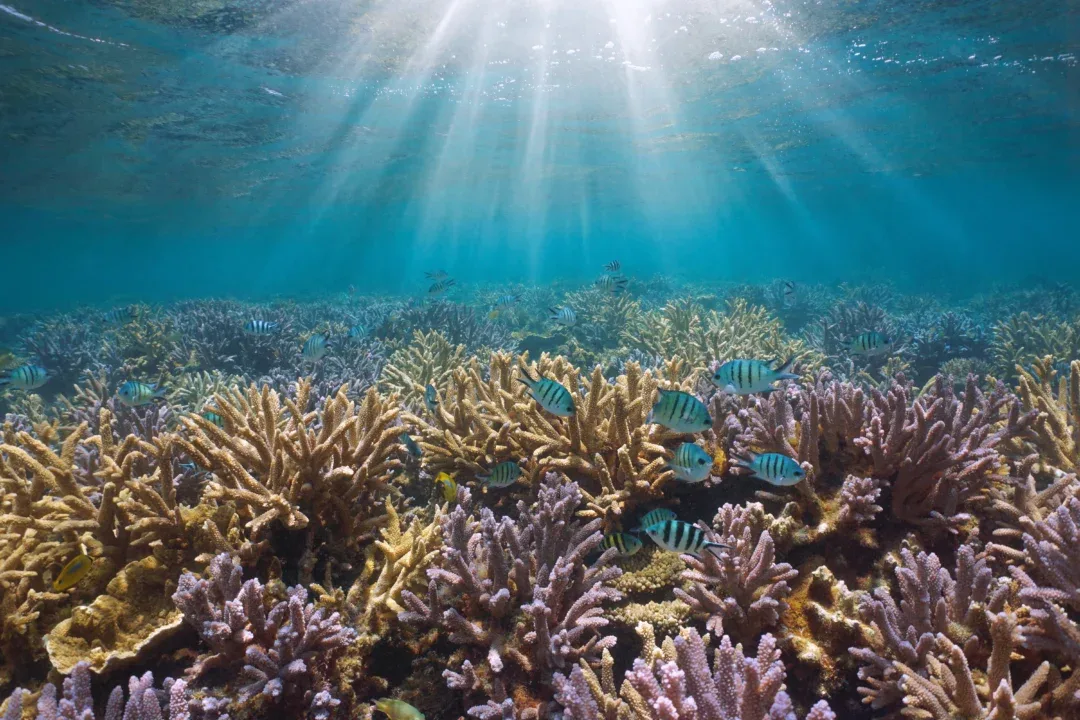 12th June 2025, Nice – A major new regional assessment launched today by the Global Coral Reef Monitoring Network (GCRMN), an operational network of the International Coral Reef Initiative (ICRI), calls for urgent and unified action to protect the future of coral reefs in the Pacific. Released at the Third United Nations Ocean Conference, the Status and Trends of Coral Reefs of the Pacific: 1980–2023 is the most comprehensive report produced on the region’s reefs to date.
12th June 2025, Nice – A major new regional assessment launched today by the Global Coral Reef Monitoring Network (GCRMN), an operational network of the International Coral Reef Initiative (ICRI), calls for urgent and unified action to protect the future of coral reefs in the Pacific. Released at the Third United Nations Ocean Conference, the Status and Trends of Coral Reefs of the Pacific: 1980–2023 is the most comprehensive report produced on the region’s reefs to date.
The Pacific harbours over 26% of the world’s coral reefs, spanning 65,255 km² across 30 countries and territories. These ecosystems are far more than biodiversity hotspots: they are the lifeblood of Pacific societies — sustaining fisheries, protecting coastlines, and anchoring cultural identity. In many Pacific communities, coral reefs are not just ecosystems but kin, ancestors, and sacred spaces. Their survival is inseparable from the survival of Pacific ways of life.
Drawing on more than 15,000 surveys from over 8,000 sites between 1987 and 2023, the GCRMN report delivers a nuanced picture: one of resilience in the face of mounting pressure, but also one that signals urgent intervention is needed.
“This report confirms what Polynesians have been observing for years: our reefs are in danger. It reinforces our conviction that the protection of coral must be a top priority, from land to sea, by combining scientific and ancestral knowledge, political decisions and local and regional actions.”
Taivini Teai, Minister of Agriculture, Marine Resources and the Environment of French Polynesia.

While many reef systems globally have experienced dramatic declines, the Pacific’s average hard coral cover remained relatively stable at 25.5% from 1990 to 2022. This resilience is remarkable and offers hope — attributed to the region’s vast geography, high ecological diversity, and relatively low human population.
Yet this seeming resilience is underlined by a changing system:
- Coral cover declined during major bleaching events — by 2.4% in 1998 and 3.7% in 2014–2017 — with recovery taking up to six years.
- The composition of coral communities is shifting away from complex branching species to more massive forms, reducing the complex three-dimensional habitat that supports biodiversity.
- Macroalgae, which compete with corals, has increased by 2.7% across the region, yet coralline algae – vital for new corals to settle – showed modest gains.
- Sea surface temperatures over coral reef areas rose by +0.82°C between 1985 and 2022, contributing to the projected increase in frequency, intensity, and duration of marine heatwaves (leading to bleaching events). e.
- From 1980 to 2023, 945 cyclones passed within 100 km of reefs, and these are expected to become more intense with climate change.
- Human populations near reefs have grown by 28.7% since 2000, increasing local pressures such as pollution and overfishing.

“We can only survive as the Pacific Islands Region if our coral reef ecosystems continue to protect and provide, as they have for generations. This report is not just science — it is our signal to the world that Pacific reefs are still fighting, and so must we. We call for global cooperation, accelerated efforts to curb the drivers of ocean warming and acidification and meaningful investment to match the scale of the threat — and the hope.”
Sefanaia Nawadra, Director General, The Secretariat of the Pacific Regional Environment Programme (SPREP)
Critically, these findings predate the ongoing Fourth Global Coral Bleaching Event — the most widespread and intense ever recorded — which has affected 84% of the world’s coral areas and is still ongoing. The report is clear: if 2023–2024 data were included, we would likely have observed a decline in coral cover in the Pacific. Even though conservation actions in the Pacific have likely aided coral cover to remain relatively stable until 2022, without bold and transformative international progress to curb climate change, the reefs of the Pacific face an uncertain future as more intense and frequent bleaching events become the norm.
“This report stands as a major reference for coral reefs in the Pacific region, and I share my deep gratitude to all the contributors that made this report possible. It highlights the unique resilience of its coral reefs, while underscoring the urgent need for coordinated, sustained, and well-resourced action in the face of mounting pressures. Through this work, our aim is to equip governments, decision-makers, and regional partners with the tools needed to strengthen monitoring, inform public policy, and support international commitments to biodiversity.”
Dr. Serge Planes, CNRS Research Director, Co-editor of the GCRMN Pacific Report

The International Coral Reef Initiative has set out clear actions for coral reefs in its Eight Key Policy Asks, from improving water quality, supporting sustainable reef fisheries, and centring Indigenous knowledge in reef governance, to scaling finance and addressing the Triple-Planetary Crisis. Pacific nations are already pioneering many of these approaches — but require greater international financial support to scale them.
The full report is available at https://gcrmn.net/pacific-report-2025-v1/.

“Alarming increases in sea surface temperatures across many places in the Pacific indicate that safeguarding coral reef ecosystems is more urgent than ever, though ICRI’s report offers hope in that many Pacific countries and territories have robust coral cover above thresholds for critical ecosystem function. As an ICRI member, WCS is proud to amplify the Initiative’s Key Policy Asks for Coral Reefs and to help mobilize the global coral reef community at UNOC3 and beyond, including through launching a new High-Level Commitment to protect climate-resilient coral reefs.”
Dr. Stacy Jupiter, Executive Director of the Wildlife Conservation Society (WCS)’s Global Marine Program.
Wicquart J., Towle E. K., Dallison T., Staub F., and Planes S. (eds.), 2025. Status and Trends of Coral Reefs of the Pacific: 1980-2023. Global Coral Reef Monitoring Network (GCRMN) and International Coral Reef Initiative (ICRI). doi.org/10.59387/WIUJ2936
